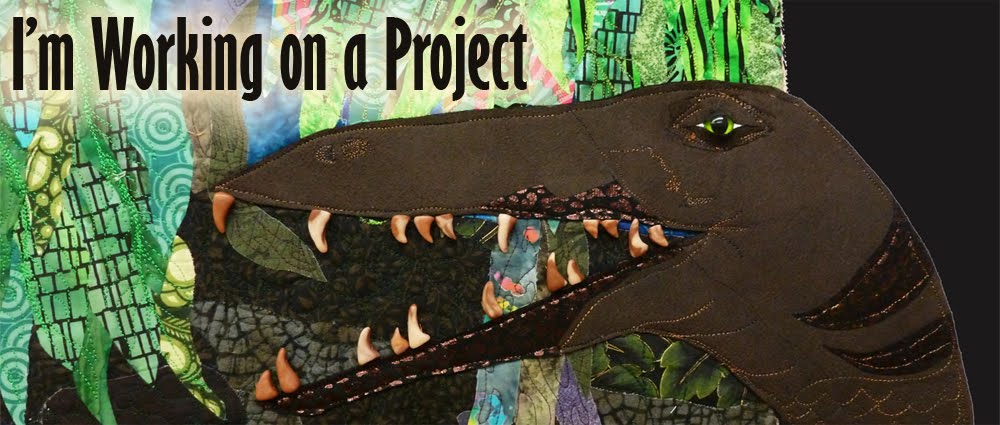This was the first exercise: draw three lines (maybe with an echo on them) on a piece of paper folded into eighths and see what kind of patterns you get. Pick your favorite and see what happens when you trace it out and start repeating the single tile. In the second picture, you can see a variety of options for edges and corners, using pieces of the same original tile.
Next, practice with shapes. The idea is to have a repeating tiling pattern, rather than a shape splotched down in the middle of a block, so the shapes go off the edge. We first worked with vessel shapes since they were easy to draw and then experimented with what happened when multiple shapes were used on the same block and what would happen if you changed the size of the shape within the block. My first attempt (first picture left and second picture) used a single pot on the tile twice. Coloring it in helps with seeing the pattern, and one of the things Jenny suggested was using slightly different colors on each tile, that is, if you have a purple pot, use different purples on each tile to give the kind of variation you might expect if you were tiling a wall with handpainted tiles. For these exercises I was just using a limited palette of colored pencils, but you get the idea. For the second tile, I used two different pot forms
Here's another version of the same exercise, same pots as above but a bigger tile so they are more spread out.
One last pot attempt- I didn't even color this one in since I felt like the proportions weren't quite right- the top of the pot overlapped the bottom of the next one, but not enough to feel intentional, only enough to look uncomfortably close.
Here's a similar exercise with different shapes. My mom drew some fish shapes, and I drew some mice.
We then practiced making tiling designs that had mirror image symmetry and rotational symmetry. I somehow managed to skip the mirror image exercise, but jumped in with two feet into some designs with rotational symmetry. We started by just drawing 1/8th of the tile on a diagonally folded square and expanding from there. In the evening after the class, I took pictures of my tiles and colored/repeated them in photoshop. The colors are pretty yucky looking- filling things in on the quick and dirty on the computer is harder than you might think but you get the idea. One of the most important things Jenny emphasized was that you really have to look at how the tile repeats to see if you'll like it since many secondary patterns only emerge in the repeats.
 |
| one tile |
 |
| four together |
 |
| many together |
The one below was more successful on that front, I love the different patterns you get where each of the four corners intersect. The only think I wasn't crazy about with this one is that all the elements were about the same width/weight, and I thought it needed a bit of variety.
After doing these exercises most of us picked a tile we liked and started interpreting it in fabric. One of the things she suggested we think about when designing was what kind of things and what amount of detail we were willing to applique. For example, for turned edge applique my design with the thistle would have been nightmarish. The other thing she talked about was what to do with the tiles. Obviously you can make a quilt with just the tiles, and I think this would have a feel like a lot of the traditional pieced quilts, where secondary patterns emerge in block intersections etc. One challenge with this for me, is that I'm usually happier when my quilts have a specific focal point (part of the problem with my previous printed tile project- thanks LeeAnna!). Jenny usually uses tiles as part of a larger project, which appeals more to my design sense.
Next I'll share the last tile I designed and my progress towards turning it into a quilt!














I don't take classes very often anymore but that one would be fantastic!
ReplyDeleteVery interesting! This is why it's so good to take classes in person. Otherwise you would have never spent two days drawing tiles but in a class it's fun! And look at how much you learned - looking forward to seeing the quilt that you come up with
ReplyDeleteSounds like fun. My favorite is the one where the vases are the negative space.Claire aka Knitnkwilt
ReplyDeleteHow lovely to be able to do a class like this - you certainly covered a lot of ground. Thanks for showing all your examples, I liked seeing how things evolved, especially as you moved from single to repeat each time. It will be very interesting to see how this grows into a quilt.
ReplyDeleteIt sounds like a wonderful class and your results are fabulous. I can't wait to to see what you do in fabric.
ReplyDeleteYou've made some wonderful designs, sounds like a very good class.
ReplyDelete